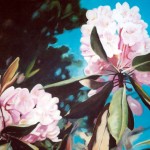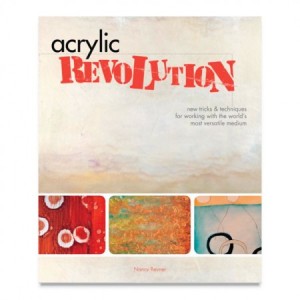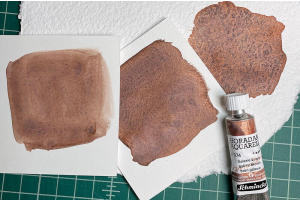We use cookies to make your experience better. To comply with the new e-Privacy directive, we need to ask for your consent to set the cookies. Learn more.
Cheap Joe’s Art Stuff Art Blog
Tips, Tricks, Thoughts, and inspiration from across the art spectrum.
The Isolation Coat - It's an Acrylic Thing, You May Not Understand

 If the phrase “isolation coat” sounds like something they slap on you when you have spent too much time in the studio, it’s probably time to think about getting out! In reality, it’s an acrylic thing, you may not understand! Acrylics are gaining in popularity and use because of their fast dry qualities, durability, and overall appeal to the masses. Regardless of age, demographics, or location, artists, of all types, find acrylics to be an “ideal” painting medium. Beginners and professional artist will agree that compared to other mediums, they can be easier to work with than watercolors, and dry faster with less unpleasant odor than oils. Making them convenient and cost-effective overall. Acrylics, however, are assumed to be indestructible because they are made of a waterproof polymer which seems to resist all elements. This is not the case at all. Acrylics are especially susceptible to fading, cracking, and peeling from their substrate if not properly protected. It is perfectly acceptable to allow acrylics to remain unvarnished, however, for longevity and conservation purposes it is recommended that a suitable layer of protection is applied. If you desire for the artwork to be enjoyed for an extended length of time, an isolation coat, along with a removable acrylic varnish, will give it the best chance at a long life. To explain isolation coats, you will first need an explanation as to why you need one. When a “final” varnish is applied, it isn’t intended to be a permanent application at all. Varnishes are used to protect a work of art from the elements, dirt, grime, environmental irritants, including the sun’s fading power. Light, in general, will eventually fade a work of art. Art is meant to be seen, so you must have light to enjoy it! When we apply varnishes to acrylics we rarely think of ever removing them at all. Most acrylic varnishes would be difficult to remove as you would risk disturbing the artwork itself by trying to clean the surface with a solvent. However, with an isolation coat, a varnish can be removed and reapplied to give an acrylic painting a fresh and clean revival back to its original beauty. Think of the varnish as a front line of defense protecting something precious. Over time, however, even the front line gets worn out and has to be replaced with a fresh new line of defenders. It is the varnish that is taking the punishment, instead of the art it is protecting. It will be worn and tattered by the elements and the sun and covered with dirt and grime, fingerprints of chocolate, perhaps. But, that is O.K. because that is its job, what it was placed here to do, but not forever. The folks at Golden Artist Colors have made it their business to make this information available to all who seek it. They have a website packed with resources and videos to help you to learn more about acrylic paints, mediums, and varnishes and how to use them. If they know, you know!
If the phrase “isolation coat” sounds like something they slap on you when you have spent too much time in the studio, it’s probably time to think about getting out! In reality, it’s an acrylic thing, you may not understand! Acrylics are gaining in popularity and use because of their fast dry qualities, durability, and overall appeal to the masses. Regardless of age, demographics, or location, artists, of all types, find acrylics to be an “ideal” painting medium. Beginners and professional artist will agree that compared to other mediums, they can be easier to work with than watercolors, and dry faster with less unpleasant odor than oils. Making them convenient and cost-effective overall. Acrylics, however, are assumed to be indestructible because they are made of a waterproof polymer which seems to resist all elements. This is not the case at all. Acrylics are especially susceptible to fading, cracking, and peeling from their substrate if not properly protected. It is perfectly acceptable to allow acrylics to remain unvarnished, however, for longevity and conservation purposes it is recommended that a suitable layer of protection is applied. If you desire for the artwork to be enjoyed for an extended length of time, an isolation coat, along with a removable acrylic varnish, will give it the best chance at a long life. To explain isolation coats, you will first need an explanation as to why you need one. When a “final” varnish is applied, it isn’t intended to be a permanent application at all. Varnishes are used to protect a work of art from the elements, dirt, grime, environmental irritants, including the sun’s fading power. Light, in general, will eventually fade a work of art. Art is meant to be seen, so you must have light to enjoy it! When we apply varnishes to acrylics we rarely think of ever removing them at all. Most acrylic varnishes would be difficult to remove as you would risk disturbing the artwork itself by trying to clean the surface with a solvent. However, with an isolation coat, a varnish can be removed and reapplied to give an acrylic painting a fresh and clean revival back to its original beauty. Think of the varnish as a front line of defense protecting something precious. Over time, however, even the front line gets worn out and has to be replaced with a fresh new line of defenders. It is the varnish that is taking the punishment, instead of the art it is protecting. It will be worn and tattered by the elements and the sun and covered with dirt and grime, fingerprints of chocolate, perhaps. But, that is O.K. because that is its job, what it was placed here to do, but not forever. The folks at Golden Artist Colors have made it their business to make this information available to all who seek it. They have a website packed with resources and videos to help you to learn more about acrylic paints, mediums, and varnishes and how to use them. If they know, you know!
Information from Golden Artist Colors website: ISOLATION COAT Only intended for acrylic paintings, do not use on oil paintings. For future conservation and varnish removal purposes, we recommend the use of an isolation coat prior to varnishing. An isolation coat is a permanent, non-removable coating that serves to physically separate the paint surface from the removable varnish. This will help protect the surface if the varnish is ever removed and make future cleaning and conservation easier to avoid working directly on top of the pigmented part of the work. Therefore, even if painted with delicate washes or large areas of colors that could potentially bleed, a clear barrier would safely cover the painted surface. It will also seal absorbent areas, which will result in a more even application of the varnish. In the event that no varnish gets applied, the isolation coat serves to decrease the water sensitivity of the paint surface, affording protection during routine cleaning/dusting.
For brush application, the appropriate isolating medium can be made by diluting Golden Soft Gel Gloss with water (2 parts by volume Golden Soft Gel Gloss to 1 part water). If a spray application is desired, a 2:1 mixture of Golden GAC-500 to Transparent Airbrush Extender can be applied with an airbrush, touch-up spray unit or commercial spray equipment. The absorbency of the surface will dictate the number of isolation layers required. For relatively non-absorbent surfaces, as is the case with a uniform paint layer, one coat brush applied or two coats spray applied is recommended. For more absorbent surfaces, which tend to be very matte, it is recommended to apply sufficient isolation coats to achieve a satin sheen on the surface. This may require two or more brush applied coats or three or more spray applications.
i
Golden Artist Colors Disclaimer The above information is based on research and testing done by Golden Artist Colors, Inc., and is provided as a basis for understanding the potential uses of the products mentioned. Due to the numerous variables in methods, materials, and conditions of producing art, Golden Artist Colors, Inc. cannot be sure the product will be right for you. Therefore, we urge product users to test each application to ensure all individual project requirements are met. While we believe the above information is accurate, WE MAKE NO EXPRESS OR IMPLIED WARRANTIES OF MERCHANTABILITY OR FITNESS FOR A PARTICULAR PURPOSE, and we shall in no event be liable for any damages (indirect, consequential, or otherwise) that may occur as a result of a product application.
NEW FROM CHEAP JOE’S- AMERICAN JOURNEY PROFESSIONAL ARTISTS’ ACRYLICS! There is still much to learn about acrylics, as they really are, relatively, still the new kid on the block. If you are a beginner, attending a suitable workshop will give you all of the basic information you need to get started. Instructors can give you tips and techniques that will further your success and progress more quickly. Check out Cathy Cranford Futral’s upcoming Acrylic Workshop at Cheap Joe’s! Sign up Now!
CATHY CRANFORD FUTRAL ART WORKSHOP: BEGINNING ACRYLIC PAINTING, JULY 21-25, 2014
This introductory art workshop is for those who have limited experience in acrylic painting and will be an exploration of color mixing, painting techniques, composition, and subject matter. Each day will start with drawing and painting tips, demos, and design information. Students will focus on designing well balanced and unified compositions and create up to 4 canvases which will include the still life, floral, and landscape. Still-life material will be provided, as well as photo references for landscape and floral subjects, but students are encouraged to bring their own ideas and photographic references. Level 1 and 2 On the other hand, if you would just like to explore the vast possibilities of acrylics, there are many books and DVDs being produced every day that will keep your creative juices flowing! The two books listed below are full of new ideas and techniques for the adventurous and daring acrylic artist!
Acrylic Revolution: New Tricks and Techniques for Working with the World’s Most Versatile Medium
Acrylic Revolution, New Tricks and Techniques for Working with the World’s Most Versatile Medium, by Nancy Reyner is an essential all-in-one guide for acrylic painting techniques and more. It features over 101 ways to break through the boundaries of conventional painting and re-define the creative potential of this all-purpose medium. For more information about Nancy check out her website!
Acrylic Innovation, Styles and Techniques Featuring 64 Visionary Artists
Acrylic Innovation, Styles and Techniques Featuring 64 Visionary Artists by Nancy Reyner. Acrylic is often used as a substitute for oil paint or watercolor, but the real gold mine is in allowing the medium freedom to do what it does best. This book shows how today’s artists are doing exactly that. It’s loaded with original artwork and valuable insight from 64 artists, incredibly diverse in styles and subjects, each using acrylic in unique ways to create expressive and personal art. Find out more about Nancy Reyner at her website. Use It or Lose It! So, now you know and hopefully understand how important this little extra step can be to enable your art to survive the elements and be enjoyed for years to come! Most of us paint for pleasure, however, for professional artists and the collectors of artworks, the omission of the process can wear heavily on their investment! New discoveries are being made every day in the expression and creation of art. There seems to be something new around every corner. Take time to explore a new idea or medium today! Happy “Isolate your Art” Day! And Keep On Painting On!













